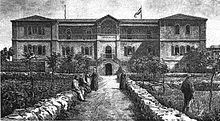Hansen House
Coordinates: 31 ° 46 ′ 3.7 ″ N , 35 ° 13 ′ 1 ″ E
The Hansen House ( Hebrew בית הנסן) is a historic building in Jerusalem , Israel . It is located in the affluent district of Talbiya, diagonally across from the Jerusalem Theater in the Motti Garden , a park. Since the late 19th century it was a nursing home called "Jesus Hilfe" for people suffering from leprosy , later the Hansen Hospital. Leprosy is also called Hansen's disease after the discoverer of the causative agent of the disease, Gerhard Armauer Hansen , hence the name of the hospital. The building served as a national leprosy center until 2000. The house and its 0.8 hectare property were declared Israeli cultural heritage in 2011 and is now called Hansen House .
history
The leprosy asylum "Jesus Hilfe" had its first seat in one at the instigation of the Baroness Augusta von Keffenbrink -Ascheraden, née. Countess von Kielmannsegg (1835–1889) in Jerusalem, which was inaugurated in May 1867 and which 12 sick people moved into in November. The two-story building complex was designed by Conrad Schick , a German missionary who had become familiar with architecture by himself, with a four-sided inner courtyard and a walkway open to the courtyard on the first floor. In order to countersign his plans, Schick won the graduate architect Theodor Sandel . In addition to the brick building with four water cisterns, there was a vegetable garden, fruit trees and livestock. The house was built on a 0.8 hectare property, which was a little remote northwest of the German colony. It is a square, two-story building with a paved courtyard. The individual rooms can be reached via arcades . Meter-thick stone walls support the cross vaults over the basement and ground floor. The building is determined by the style of symmetry that dominates almost all of Jerusalem's Christian-European architecture. David Kroyanker describes the building as one of the most beautiful in Jerusalem.
Foster sisters and house parents were sent to Jerusalem by the Moravian Brethren . The first housefather was the missionary Friedrich Tappe (1824–1897), the medical director of the English Thomas Chaplin. The sick were mostly Arabs from the area. The annual donations from the states of the German Confederation amounted to 2000 thalers and according to the visitor Paul Langerhans was very tight. In addition to Chaplin, the Prussian consul Georg Rosen , the missionary Conrad Schick , the Swiss banker Johannes Frutiger and the Anglican bishop of Jerusalem Samuel Gobat were involved in the local committee .
In 1887, on the initiative of the German Protestant community in Jerusalem, the leper asylum "Jesus Hilfe" was founded in today's Hansen House to care for leprosy patients. At that time the disease was incurable. The asylum had 60 beds and was run by the Moravian Brethren until 1950 . Lepers of all religions found protection and care in it, most of them were Muslims, some were Christians and Jews. In 1950 the church sold the complex to the Jewish National Fund . Under the management of the Ministry of Health of the State of Israel, it was renamed Hansen Hospital . After leprosy was effectively treated, the patients were gradually discharged, the last leaving the hospital in 2000. Until 2009 the house served as a day clinic where leprosy patients received outpatient treatment. However, it was partially used for artistic activities.
Conversion to a cultural center and renovation in 2011
Since 2009, a permanent exhibition entitled Behind the Wall - The Story of the Leper Home in Jerusalem has documented the history of the house from the end of the 19th century until today. The administration of the house was handed over to the Jerusalem City Council. The Jewish National Fund agreed to the conversion from a hospital to a public cultural center. The building structure lasted from 2011 to 2013 preserving renovation. Under the name of Hansen House. Center of Design, Media and Technology , the building now serves as an exhibition space for fine arts and a venue for multimedia events.
The resulting in 2014 in the Hansen House art project The eternal sukkah , one made of a Bedouin house Tabernacles , was established in 2015 by the Israel Museum purchased and exhibited there. A Wikimedia hackathon took place here in 2015 . Masters students from the Bezalel Academy of Arts and Design also study at Hansen House.
literature
- Adolf Schmidtmann : The leper asylum "Jesus Help" near Jerusalem and the leprosy in Palestine , in: Dermatologische Zeitschrift , 1899, issue 6, pp. 588-596; first in: Quarterly magazine for forensic medicine and public health services. Episode 3, Vol. 18 (1899), pp. 113-122. Internet Archive
Web links
- Website Hansen House (English)
Individual evidence
- ^ A b History: the Hansen Hospital , Hadassah Medical Center
- ↑ David Kroyanker: The architecture of Jerusalem, 1994., ISBN 3-17-013165-6 , p 123
- ↑ Dr Thomas Chaplin, Scientist and Scholar in Nineteenth-Century Palestine , in: Palestine Exploration Quarterly (PEQ), Volume 136, Issue 2, 2004
- ^ Paul Langerhans: Lepra and Leproserien in Jerusalem , in: Archives for pathological anatomy and physiology and for clinical medicine. Volume 50, Issue 3, 1870, pp. 453-455
- ↑ Hans Hermann Frutiger, Ejal Jakob Eisler: Johannes Frutiger. A Swiss banker in Jerusalem 1836–1899 . Böhlau, Cologne 2008, p. 330.
- ↑ Adolf Schmidtmann : The leper asylum "Jesus Help" near Jerusalem and the leprosy in Palestine , Dermatologische Zeitschrift, Vol. 6, No. 5, 1899, pp. 588-596. doi : 10.1159 / 000241459
- ^ Graham Lawson: Building 'The Eternal Sukkah'. In: The Jerusalem Post . September 8, 2015, accessed November 1, 2017 .
- ↑ Lea Mauas, Diego Rotman: The Eternal Sukkah. In: Rosa Luxemburg Foundation Israel Office. December 2016, accessed November 1, 2017 .
- ^ "Becoming" opens at Jerusalem Hansen House







